1996 CADILLAC SEVILLE overheating
[x] Cancel search: overheatingPage 82 of 354
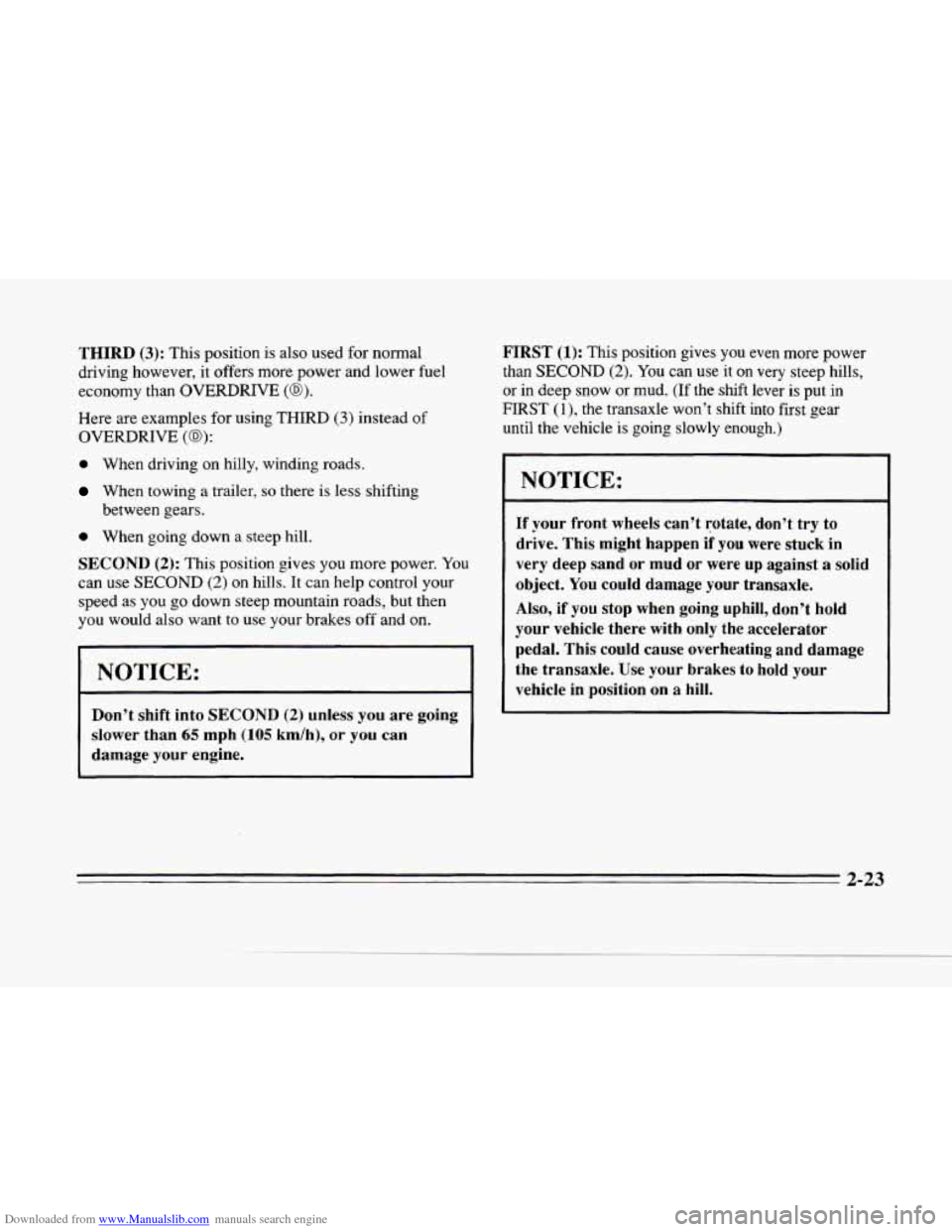
Downloaded from www.Manualslib.com manuals search engine r..
L
THIRD (3): This position is also used for normal
driving however, it offers more power and lower fuel
economy than OVERDRIVE
(@).
Here are examples for using THIRD (3) instead of
OVERDRIVE (a):
0 When driving on hilly, winding roads.
When towing a trailer, so there is less shifting
between gears.
0 When going down a steep hill.
SECOND (2): This position gives you more power. You
can use SECOND
(2) on hills. It can help control your
speed as
you go down steep mountain roads, but then
you would also want to use your brakes
off and on.
I NOTICE:
r
~~
Don’t shift into SECOND (2) unless you are going
slower than
65 mph (105 km/h), or you can
damage your engine. FIRST
(1): This
position gives you even more power
than SECOND
(2). You can use it on very steep hills,
or in deep snow or mud. (If the shift lever is put in
FIRST (l), the transaxle won’t shift into first gear
until the vehicle is going slowly enough.)
NOTICE:
If your front wheels can’t rotate, don’t try to
drive. This might happen if you were stuck in
very deep sand or mud or were
up against a solid
object.
You could damage your transaxle.
Also, if you stop when going uphill, don’t hold
your vehicle there with only the accelerator
pedal. This could cause overheating and damage
the transaxle.
Use your brakes to hold your
vehicle in position on
a hill.
2-23
Page 130 of 354
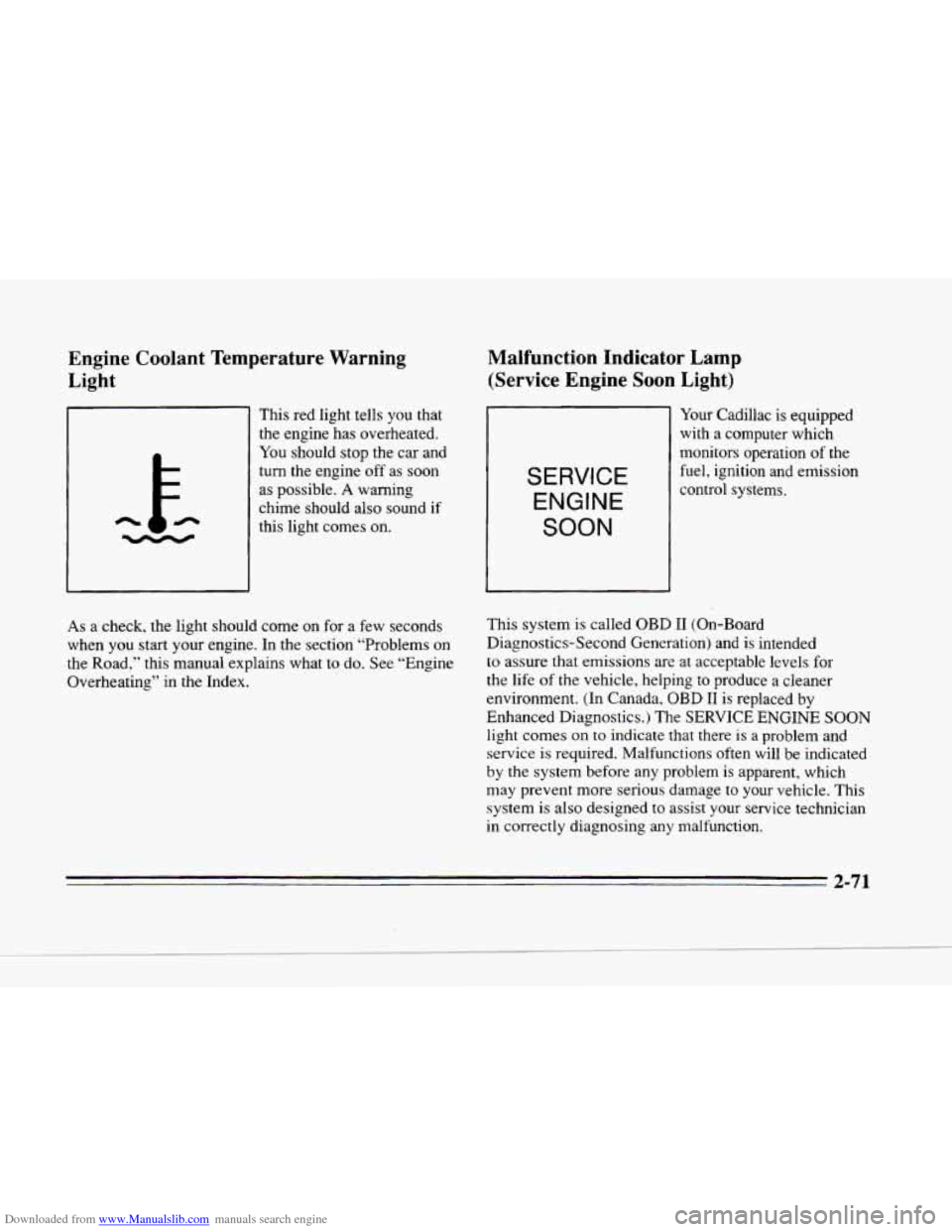
Downloaded from www.Manualslib.com manuals search engine Engine Coolant Temperature Warning
Light
This red light tells you that
the engine has overheated.
You should stop the car and
turn the engine off as soon
as possible.
A warning
chime should also sound if
this light comes on.
As a check, the light should come on for a few seconds
when you start your engine. In the section “Problems on
the Road,” this manual explains what to do. See “Engine
Overheating’’ in the Index.
Malfunction Indicator Lamp
(Service Engine
Soon Light)
SERVICE
ENGINE
SOON
Your Cadillac is equipped
with a computer which
monitors operation of the
fuel, ignition and emission
control systems.
This system is called OBD
I1 (.On-Board
Diagnostics-Second Generation) and is intended
to assure that emissions are at acceptable levels for
the life
of the vehicle, helping to produce a cleaner
environment. (In Canada,
OBD I1 is replaced by
Enhanced Diagnostics.) The SERVICE ENGINE SOON
light comes on to indicate that there is a problem and
service is required. Malfunctions often will be indicated
by the system before any problem is apparent, which
may prevent more serious damage to your vehicle. This
system is also designed
to assist your service technician
in correctly diagnosing any malfunction.
2-71
Page 141 of 354
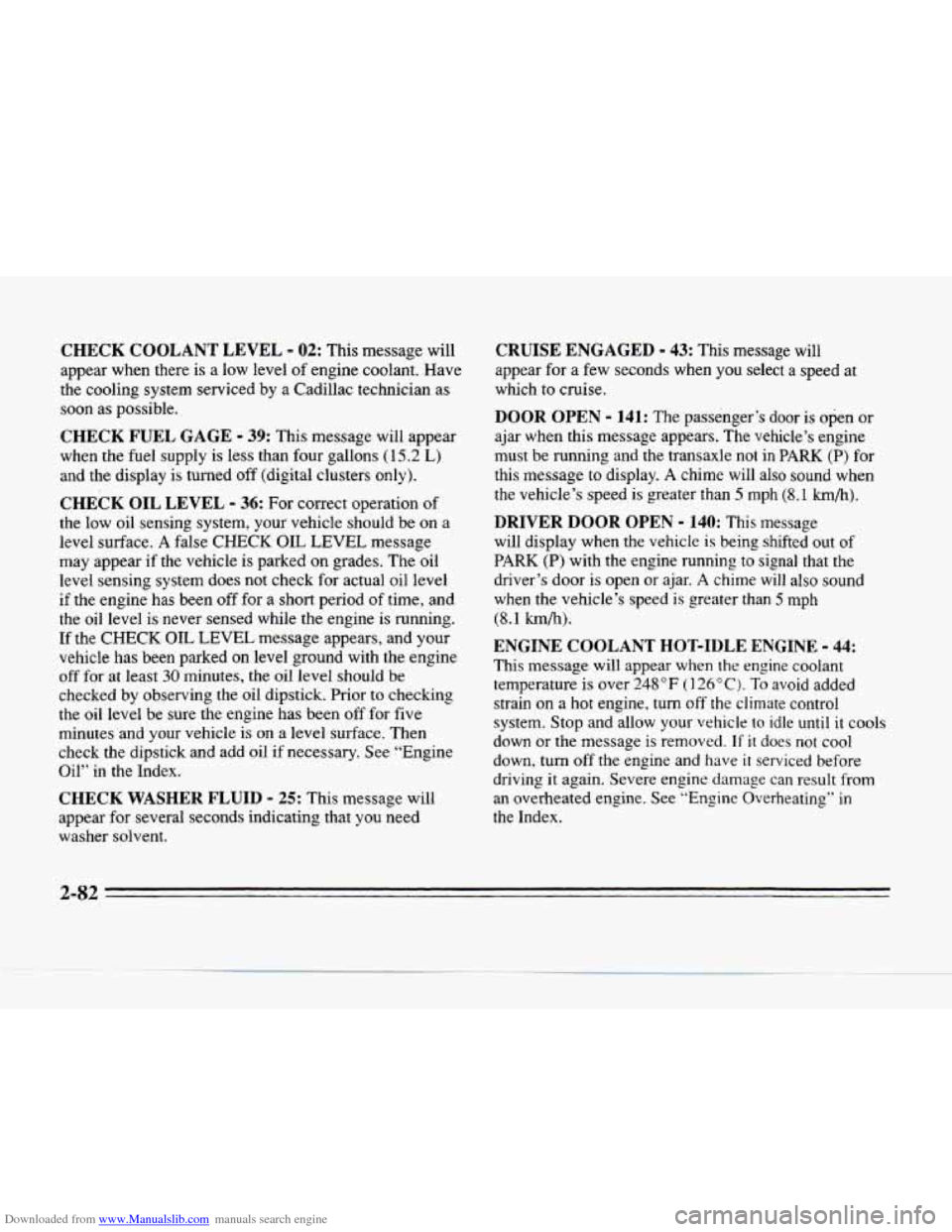
Downloaded from www.Manualslib.com manuals search engine CHECK COOLANT LEVEL - 02: This message will
appear when there is a low level of engine coolant. Have
the cooling system serviced by a Cadillac technician
as
soon as possible.
CHECK FUEL GAGE - 39: This message will appear
when the fuel supply is less than four gallons
(15.2 L)
and the display is turned off (digital clusters only).
CHECK OIL LEVEL - 36: For correct operation of
the low oil sensing system, your vehicle should be on a
level surface.
A false CHECK OIL LEVEL message
may appear if the vehicle
is parked on grades. The oil
level sensing system does not check for actual oil level
if the engine has been off for
a short period of time, and
the oil level is never sensed while the engine is running.
If the CHECK OIL LEVEL message appears, and your
vehicle has been parked on level ground with the engine
off
for at least 30 minutes, the oil level should be
checked by observing the
oil dipstick. Prior to checking
the oil level be sure the engine has been off for five
minutes and your vehicle
is on a level surface. Then
check the dipstick and add oil if necessary. See “Engine
Oil” in the Index.
CHECK WASHER FLUID - 25: This message will
appear
for several seconds indicating that you need
washer solvent.
CRUISE ENGAGED - 43: This message will
appear for
a few seconds when you select a speed at
which to cruise.
DOOR OPEN - 141: The passenger‘s door is open or
ajar when this message appears. The vehicle’s engine
must be running and the transaxle not
in PARK (I?) for
this message to display. A chime will also sound when
the vehicle’s speed is greater than
5 mph (8.1 km/h).
DRIVER DOOR OPEN - 140: This message
will display when the vehicle is being shifted out of
PARK (P) with the engine running to signal that the
driver’s door
is open or ajar. A chime will also sound
when the vehicle’s speed
is greater than 5 mph
(8.1 km/h).
ENGINE COOLANT HOT-IDLE ENGINE - 44:
This message will appear when the engine coolant
temperature is over
248 “F ( 1 24°C). To avoid added
strain on a hot engine, turn
off the climate control
system. Stop and allow your vehicle
to idle until it cools
down
or the message is removed. If it does not cool
down, turn off the engine and
have it serviced before
driving it again. Severe engine damage can result from
an overheated engine. See
“Engine Overheating” in
the Index.
2-82
Page 144 of 354
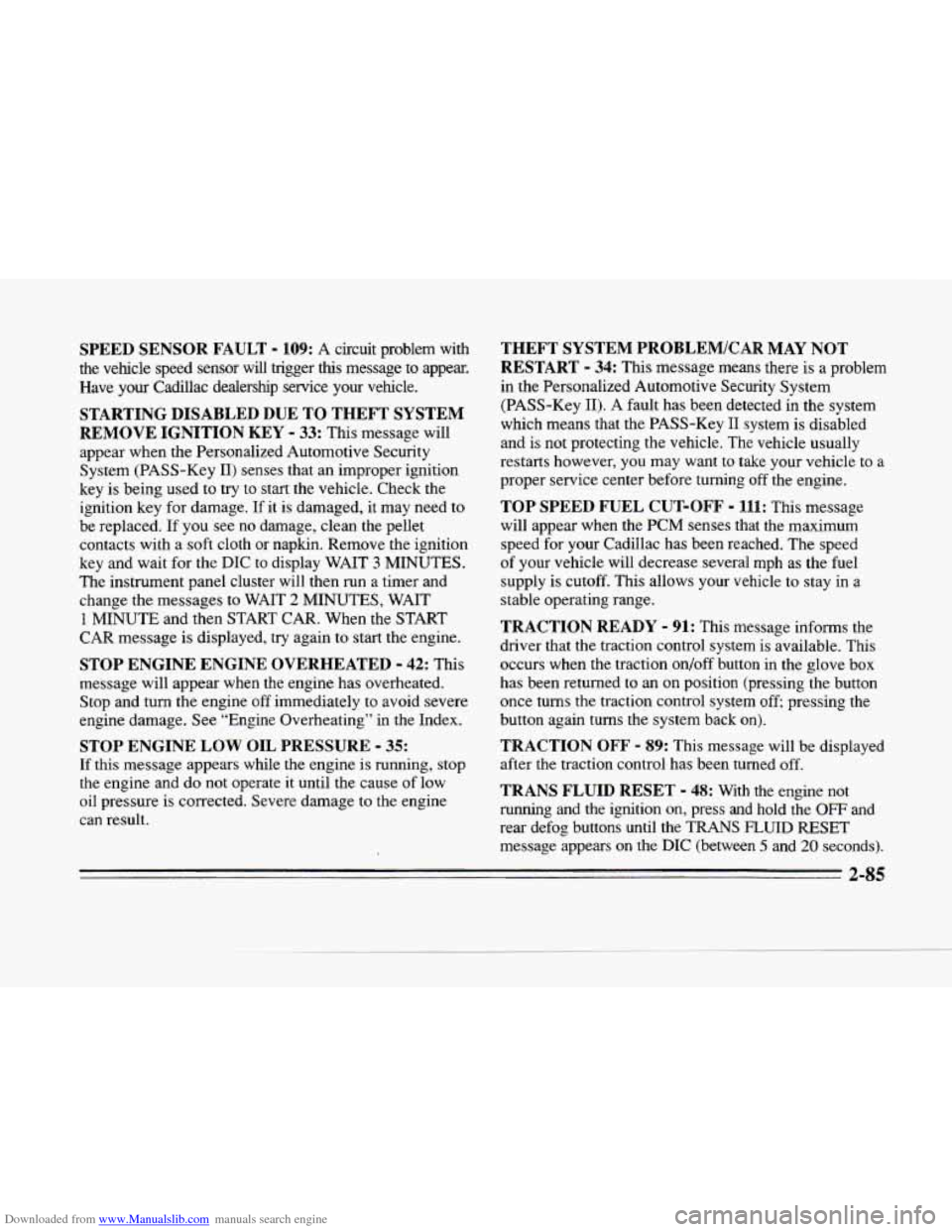
Downloaded from www.Manualslib.com manuals search engine SPEED SENSOR FAULT - 109: A circuit problem with
the vehicle speed sensor
will trigger this message to appear.
Have
your Cadillac dealership service your vehicle.
STARTING DISABLED DUE TO THEFT SYSTEM
REMOVE IGNITION KEY
- 33: This message will
appear when the Personalized Automotive Security
System (PASS-Key
11) senses that an improper ignition
key is being used to
try to start the vehicle. Check the
ignition key for damage.
If it is damaged, it may need to
be replaced. If you see no damage, clean the pellet
contacts with
a soft cloth or napkin. Remove the ignition
key and wait for the
DIC to display WAIT 3 MINUTES.
The instrument panel cluster will then run a timer and
change the messages to WAIT
2 MINUTES, WAIT
1 MINUTE and then START CAR. When the START
CAR message is displayed, try again to start the engine.
STOP ENGINE ENGINE OVERHEATED - 42: This
message will appear when the engine has overheated.
Stop and turn the engine off immediately to avoid severe
engine damage. See “Engine Overheating” in the Index.
STOP ENGINE LOW OIL PRESSURE - 35:
If this message appears while the engine is running, stop
the engine and do not operate it until the cause of low
oil pressure is corrected. Severe damage to the engine
can result.
THEFT SYSTEM PROBLEMKAR MAY NOT
RESTART
- 34: This message means there is a problem
in the Personalized Automotive Security System
(PASS-Key
11). A fault has been detected in the system
which means that the PASS-Key
I1 system is disabled
and is not protecting the vehicle. The vehicle usually
restarts however, you may want to take your vehicle to a
proper service center before turning off the engine.
TOP SPEED FUEL CUT-OFF - 111: This message
will appear when the
PCM senses that the maximum
speed for your Cadillac has been reached. The speed
of your vehicle will decrease several mph as the fuel
supply is cutoff. This allows your vehicle to stay in a
stable operating range.
TRACTION READY - 91: This message informs the
driver that the traction control system is available. This
occurs when the traction on/off button in the glove box
has been returned to an on position (pressing the button
once turns the traction control system off; pressing the
button again turns the system back
on).
TRACTION OFF - 89: This message will be displayed
after the traction control has been turned off.
TRANS FLUID RESET - 48: With the engine not
running and the ignition on, press and hold the
OFF and
rear defog buttons until the
TRANS FLUID RESET
message appears on the
DIC (between 5 and 20 seconds).
2-85
Page 220 of 354
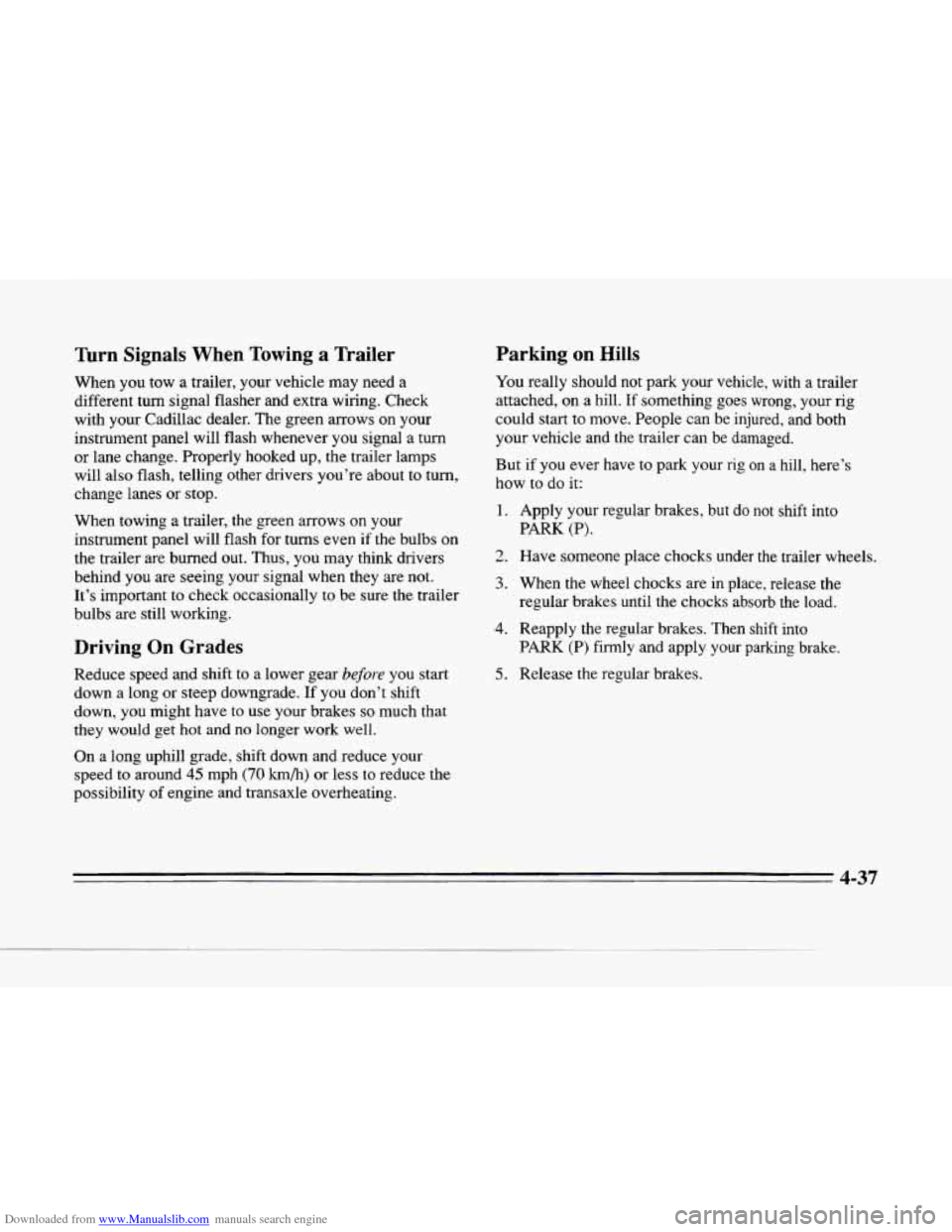
Downloaded from www.Manualslib.com manuals search engine rr
L.
h
c
c
Turn Signals When Towing a Trailer
When you tow a trailer, your vehicle may need a
different turn signal flasher and extra wiring. Check
with your Cadillac dealer. The green arrows on your
instrument panel will flash whenever you signal a turn
or lane change. Properly hooked up, the trailer lamps
will also flash, telling other drivers you’re about to turn,
change lanes or stop.
When towing a trailer, the green arrows on your
instrument panel will flash for turns
even if the bulbs on
the trailer are burned
out. Thus, you may think drivers
behind you are seeing your signal when they are not.
It’s important to check occasionally to be sure the trailer
bulbs
are still working.
Driving On Grades
Reduce speed and shift to a lower gear before you start
down a long or steep downgrade.
If you don’t shift
down, you might have to use your brakes
so much that
they would
get hot and no longer work well.
On a long uphill grade, shift down and reduce your
speed to around
45 mph (70 km/h) or less to reduce the
possibility of engine and transaxle overheating.
Parking on Hills
You really should not park your vehicle, with a trailer
attached, on a hill. If something goes wrong, your rig
could start to move. People can be injured, and both
your vehicle and the trailer can be damaged.
But if you ever have to park your
rig on a hill, here’s
how to do it:
1.
2.
3.
4.
5.
Apply your regular brakes, but do not shift into
PARK
(P).
Have someone place chocks under the trailer wheels.
When the wheel chocks
are in place, release the
regular brakes until the chocks absorb the load.
Reapply the regular brakes. Then shift into
PARK (P) firmly and apply your parking brake.
Release the regular brakes.
4-37
Page 236 of 354
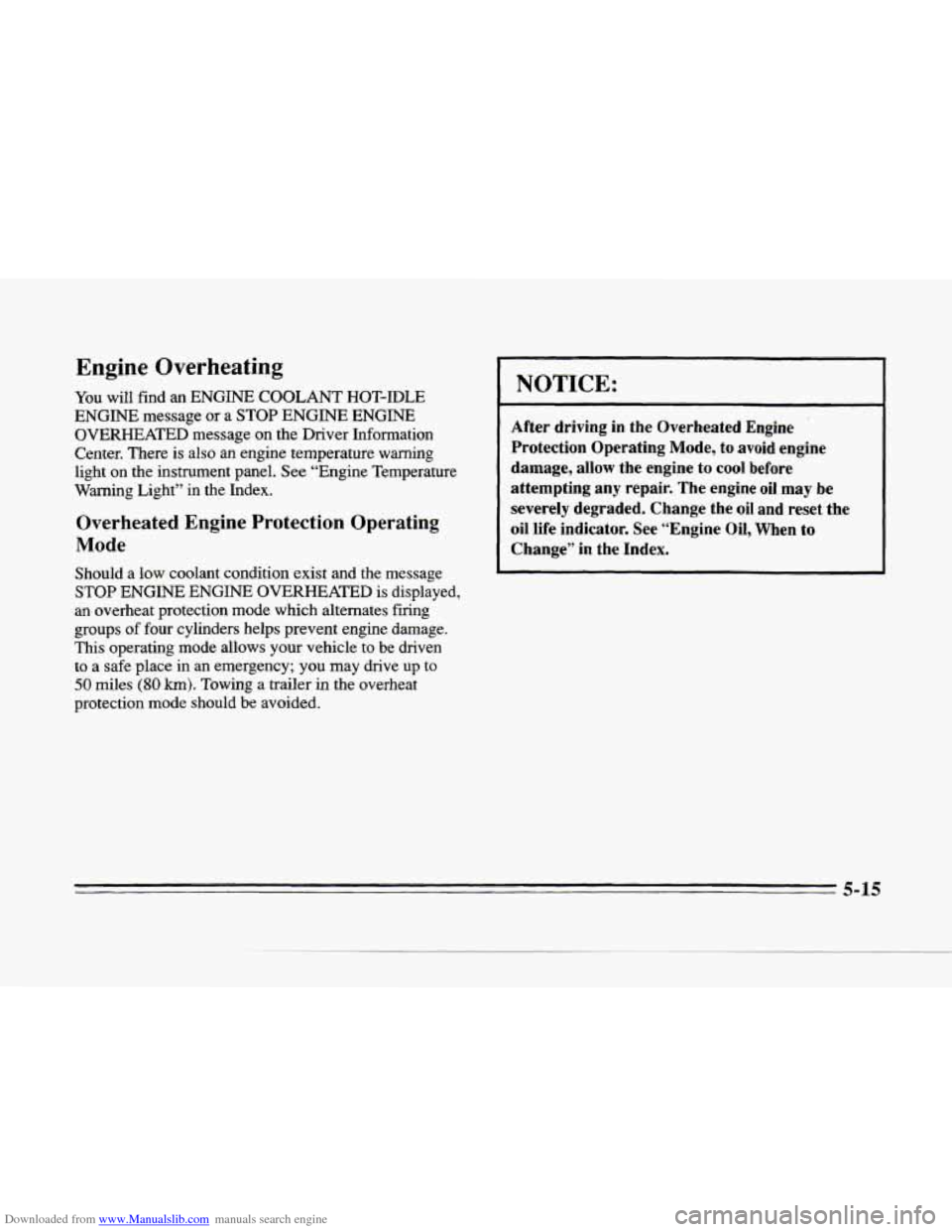
Downloaded from www.Manualslib.com manuals search engine L
rc
Engine Overheating
You will find an ENGINE COOLANT HOT-IDLE
ENGINE message
or a STOP ENGINE ENGINE
OVERHEATED message on the Driver Information
Center. There is also an engine temperature warning
light on the instrument panel. See “Engine Temperature
Warning Light”
in the Index.
Overheated Engine Protecaon Operating
Mode
Should a low coolant condition exist and the message
STOP ENGINE ENGINE OVERHEATED is displayed,
an overheat protection mode which alternates firing
groups
of four cylinders helps prevent engine damage.
This operating mode allows your vehicle
to be driven
to
a safe place in an emergency; you may drive up to
50 miles (80 km). Towing a trailer in the overheat
protection mode should be avoided.
NOTICE:
After driving in the Overheated Engine
Protection Operating Mode, to avoid engine
damage, allow the engine to cool before
attempting any repair. The engine oil may be
severely degraded. Change the
oil and reset the
oil life indicator. See “Engine Oil, When to
Change” in the Index.
5-15
Page 241 of 354
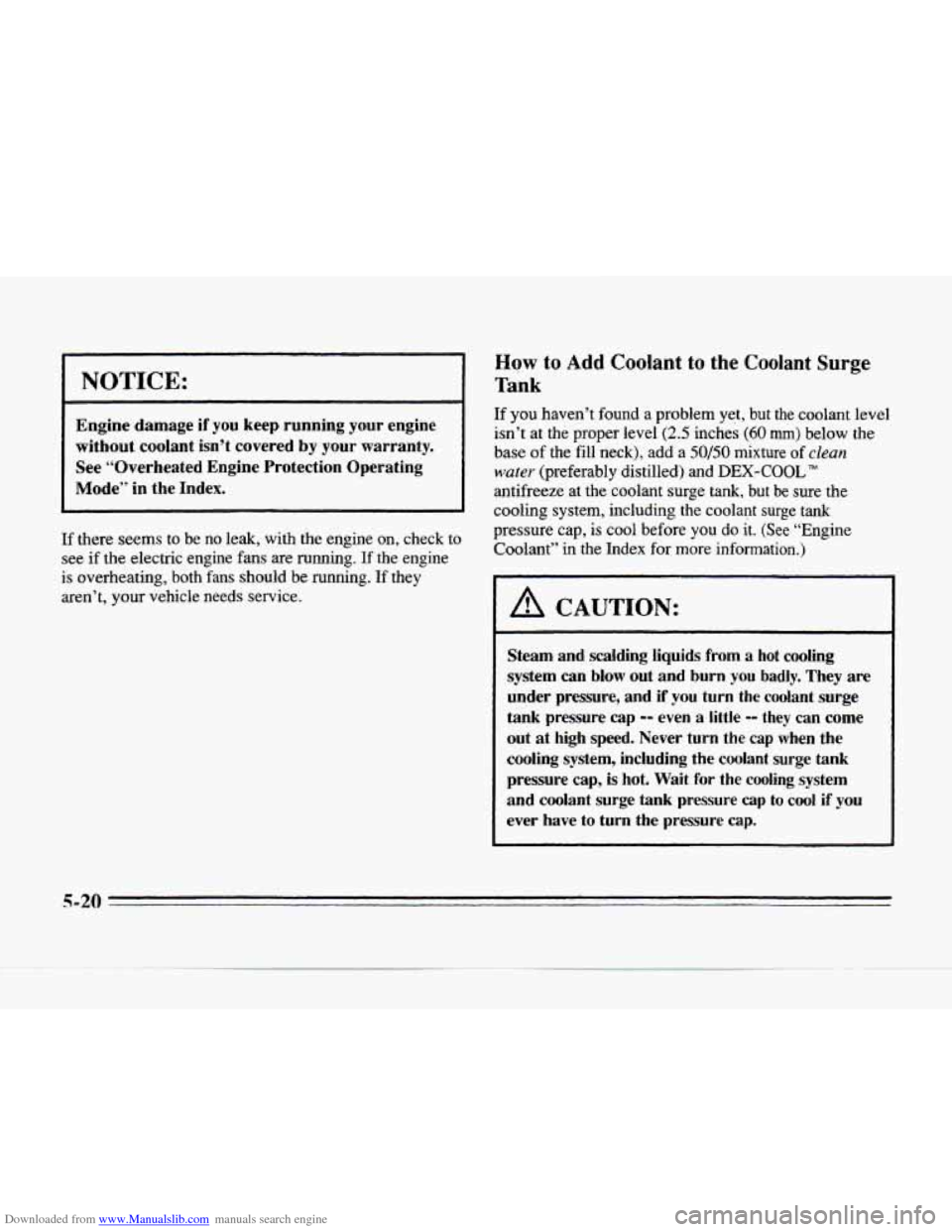
Downloaded from www.Manualslib.com manuals search engine I NOTICE:
Engine damage if you keep running your engine
without coolant isn’t covered
by your warranty.
See “Overheated Engine Protection Operating
Mode’? in the Index.
If there seems to be no leak, with the engine
on, check to
see if
the electric engine fans are running. If the engine
is overheating, both
fans should be running. If they
aren’t, your vehicle needs service.
How to Add Coolant to the Coolant Surge
Tank
If you haven’t found a problem yet, but the coolant level
isn’t at the proper level (2.5 inches (60 mm) below the
base of the fill neck), add
a 50/50 mixture of clean
water (preferably distilled) and DEX-COOL TM
antifreeze at the coolant surge tank, but be sure the
cooling system, including the coolant surge tank
pressure cap, is cool before
you do it. (See “Engine
Coolant” in the Index
for more information.)
A CAUTION:
Steam and scalding liquids from a hot cooling
system can blow out and
burn you badly. They are
under pressure, and if you turn the coolant surge
tank pressure
cap -- even a little -- they can come
out at high speed. Never turn the
cap when the
cooling system, including the coolant surge tank
pressure cap, is hot. Wait
for the cooling system
and coolant surge tank pressure
cap to cool if you
ever have to turn the pressure cap.
5-20
Page 279 of 354
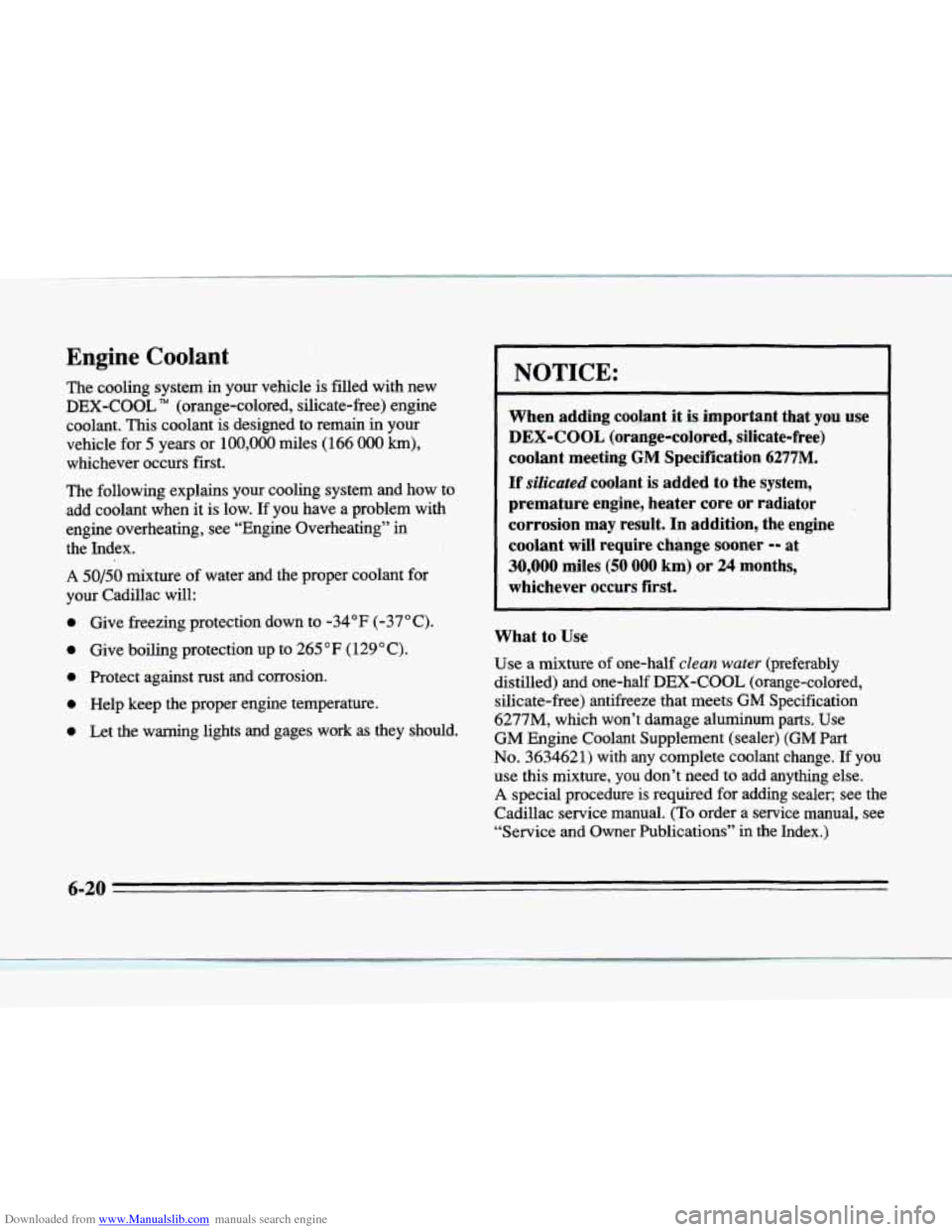
Downloaded from www.Manualslib.com manuals search engine Engine Coolant
The cooling system in your vehicle is filled with new
DEX-COOL rm (orange-colored, silicate-free) engine
coolant. This coolant is designed to remain
in your
vehicle
for 5 years or 100,000 miles (1 66 000 km),
whichever occurs first.
The following explains your cooling system and how to
add coolant when it is low.
If you have a problem with
engine overheating, see “Engine Overheating” in
the Index.
A 50/50 mixture of water and the proper coolant for
your Cadillac will:
0 Give freezing protection aown to -34°F (-37°C).
0 Give boiling protection up to 265 “F (129 O C).
0 Protect against rust and corrosion.
0 Help keep the proper engine temperature.
0 Let the warning lights and gages work as they should.
NOTICE:
When adding coolant it is important that you use
DEX-COOL (orange-colored, silicate-free)
coolant meeting
GM Specification 6277M.
If dicated coolant is added to the system,
premature engine, heater core or radiator
corrosion may result. In addition, the engine
coolant
will require change sooner -- at
30,000 miles (50 000 km) or 24 months,
whichever occurs first.
What to Use
Use a mixture of one-half clean water (preferably
distilled)
and one-half DEX-COOL (orange-colored,
silicate-free) antifreeze that meets
GM Specification
6277M, which won’t damage aluminum
parts. Use
GM Engine Coolant Supplement (sealer)
(GM Part
No. 3634621) with any complete coolant change. If you
use this mixture, you don’t need to add anything else.
A special procedure is required for adding sealer; see the
Cadillac service manual.
(To order a service manual, see
“Service and Owner Publications”
in the Index.)
6-20